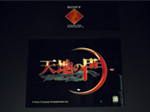
Workin' it at the Tokyo Game Show
Date: Monday, September 27 @ 14:49:23 CEST
Topic: Exhibitions
 The PSP's good looks reflect upon us, and knowing this, Sony had many of them at the TGS attached to young girls. The PSP's good looks reflect upon us, and knowing this, Sony had many of them at the TGS attached to young girls.
One of them however was attached to Tetsuya Mizuguchi, creator of Rez and one of the nicest guys at the TGS. He was there to introduce his new title in development, Lumines (Pronounced in Japanese like ‘Luminous’).
Lumines looks like a blend between an audio sequencer and Tetris. You operate a cluster of blocks the same as you would expect in a Tetris style game however a metronomic line wipes across the screen in rhythm, I guess, with the dance music.

How this exactly impacts on gameplay is a bit of a mystery though. At this stage player interactions aren’t as integral to the generation of the sound as they were in Rez, but Mizuguchi said he’s still developing that along with the graphical drama. He stressed above all the simplicity of the gameplay and it prompted me to think about his efforts to pull away from the challenge inherent in the gaming tradition. He’s not looking for a fight, he just wants you to sit back, relax and enjoy.
When asked about developing on the PSP, Mizuguchi said, “It’s been an adventureâ€. But he looks very much on top of things and I have to say that his work is well suited to the lifestyle that the PSP promises.
 There were many PSP games on show of course but the one that caught my
action-adventure eye was Tenchi no Mon, which translates something like,
'Gate of Heaven on Earth'. To put it into perspective, this title looks
better than the new Arc the Lad on the PS2. Not only did it give you
elaborate and interesting sword combos and an ancient Japanese setting,
but the feeling of running down a wide, grassy hill is what did it for
me, standing there holding the PSP.
There were many PSP games on show of course but the one that caught my
action-adventure eye was Tenchi no Mon, which translates something like,
'Gate of Heaven on Earth'. To put it into perspective, this title looks
better than the new Arc the Lad on the PS2. Not only did it give you
elaborate and interesting sword combos and an ancient Japanese setting,
but the feeling of running down a wide, grassy hill is what did it for
me, standing there holding the PSP.
Another person, like Mizuguchi, whose job it is to make games cooler is Hideo Kojima. The Metal Gear Solid 3: Snake Eater IP is hot. It was one of the few games you couldn’t take any photos of and the scene was patrolled by more enemies than in the game itself. Kojima and his budget continue to defy what is thought can be done on the PS2. It looks really, really good, and you can climb trees.

Also to his credit is the style with which the game is being marketed. The camp Bond-like soundtrack plays on the drama of a game where emotions are clearly lacking, and the very idea of a game about someone who eats snakes is enjoyable. Why their TGS promo is a pamphlet in the shape of an old vinyl record is beyond me though, but I guess that’s cool for Kojima.
If IREM had spent as much time improving the physics, animations and general quality of their Zetsumei series as they did on building a small destroyed building in which to show their demo video at TGS, then, um, maybe they would have a better game in Zettai Zetsumei Toshi 2. I liked IREM`s Zettai Zetsumei Toshi so much that even though it kind of sucked I still defended it. To my mind it represented the potential for a relatively small team to produce an interesting concept, in this case to survive a city being destroyed by an earthquake, despite not having the means to really polish it to today’s standards. It showed that, in Japan at least, yet unproven concepts with clear potential can still sometimes get published.

Even though there are some really cool moments in Zettai Zetsumei Toshi 1, your character has the dexterity of an idiot. I mean the experience of movement in the game is bad, as bad as the textures themselves. Well they’ve addressed the color in the new game. No longer is this a true simulation of just how grey Japan can be, but the character movement hasn’t really gone anywhere. It’s so bad in fact its fun. The “Oi!†also remains, as does the crawl, and armed with these things you can have a good time, though perhaps not the one they intended. No longer are earthquakes the problem, this time your city’s about to be flooded, hence the blue logo. As rushing water pushes you further away from where you want to go you have to try and grab onto whatever you can. Where in the first game you had to find water to quench your thirst, now you must find a heater to dry yourself by. Thumbs up to a design team obviously struggling who take on the impossibly difficult proposition of a whole city engulfed by water on the PS2.
I did see HL2 played in the flesh during the seminar at TGS, though it was the same zones that we’ve all seen played out in movies on the web and I don’t really have anything to add. Greg Coomer, one of the nicest guys at the TGS and one of the original Valve team that split off from Microsoft back in the day, did however discuss the Gravity gun as being literally a solution to not having truly functional hands in-game.

Later that night I was talking with Greg, when the shy genius behind ICO, Fumito Ueda, was introduced by his not so shy friends. As a gift for being allowed play some Half Life 2 on Greg’s laptop, they proceeded to show the original demo movies that led to ICO. Let me stress this was a treat. The fidelity with which the game managed to stick to the original vision built in Lightwave was astonishing. There were easily recognizable scenes and sets, in fact most everything I saw in those movies I remembered in the final game. This includes not only a falling chandelier and a rickety walkway against a waterfall backdrop, but also the overall lighting and color of the stones and leaves.
It was pointed out that the Ico`s horns originally pointed backwards, but Sony, feeling they looked too feminine, twisted them around to make us feel stronger. As for the shadowy monsters, the original concept gave them form and color, but the load on the PS2 meant that a choice had to be made between settling with less than realistic human-like enemies, or trying something new.
Greg spoke up and said that he also employed such movies as one of the best ways to communicate to the HL2 team. After presenting a talk earlier that night covering storytelling and Half Life 2, I thought it was something to hear him say that the scene in ICO towards the end, when you almost fall to your death near, was one of the most emotionally charged storytelling moments he’d ever experienced in a game.
Fumito Ueda is 34 years old and one of the nicest guys in the industry. When I asked him about his role on Wanda and Colossus he said, in Japanese, “I have to talk to someone elseâ€. So I really didn’t learn anything about the new game from the ICO team, although, if watching their earlier demo movies is anything to go by, unlike some reports I’ve read, I’d say there is a long way to go before we see any real gameplay from the magic looking, Wanda and Colossus.
|
|